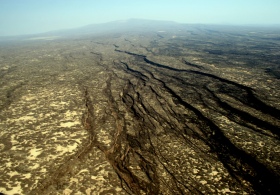What's cooking under Africa?

Earth scientists unravel the mysteries of magmatism and rifting in the Afar depression in Ethiopia.
The surface of the Earth is in constant turmoil. The thick tectonic plates that make up our continents and ocean floors are in perpetual movement, slowly pulling apart, coming together or sliding past each other. Early clues to these movements came from the matching coastlines of continents such as Africa and South America, leading to the idea of plates forming a big continental jigsaw puzzle. Today, we can monitor the movement of tectonic plates (plate tectonics) with very sensitive equipment and satellite images. But these movements remain difficult to comprehend, and observe, on our human scale.
Not in Africa. There, in the scorching heat of Afar in Ethiopia, plate tectonics is happening right now, and we can see it. Under Afar’s tortuous landscape, tectonic plates are slowly pulling apart in what is known as a rift zone. Rifting can be the beginning of full-scale breakup of two continental plates, eventually leading to the formation of a new ocean, bound by two matching continents.
Such rifting is often accompanied by voluminous magmatism, a process where large amounts of molten rock, or magma, intrude into the surface layers of the Earth. We know this is the case because we find evidence for solidified magma in the geological record at ancient rifted margins. The reason for this large-scale magmatism, however, has been puzzling Earth scientists for decades.
In a paper published this month in the journal Nature, an international team of Earth Scientists, including scientists from Imperial College London, explained the reasons behind the extensive magmatism at Afar.
 The authors used two models to study the origin of the melt. Based on the chemical composition of lavas erupted at the rift zone, they developed a geochemical model of magmatism. They concluded that the melting occurs very deep in the Earth, 80 km or more below Afar, in an anomalously hot region of the mantle.
The authors used two models to study the origin of the melt. Based on the chemical composition of lavas erupted at the rift zone, they developed a geochemical model of magmatism. They concluded that the melting occurs very deep in the Earth, 80 km or more below Afar, in an anomalously hot region of the mantle.
Using a second model, the authors found that the speed of rifting in Ethiopia is sufficiently slow for the hot plate being pulled apart to cool and retain its thickness, despite the region being in the very advanced stages of breakup. These results led the authors to two conclusions: the melting at Afar is hot and it’s deep. If Afar is to see the birth of a new sea, the required thinning of the tectonic plate will have to happen abruptly, at the final stages of breakup.
Dr Ian Bastow, lecturer in the department of Earth Sciences and Engineering at Imperial College London, is one of the authors of this paper:
Marion Ferrat: Why is Afar such an important place for scientists to study plate tectonics?
Ian Bastow: In Afar one can observe the earthquakes and volcanoes that characterise the final stages of continental breakup. This offers a distinct advantage over study at the so-called rifted margins, where all we have left to study are the rocks and structures that formed during the breakup millions of years ago.
Marion Ferrat: Did you carry out fieldwork in Afar? What is it like there?
Ian Bastow: I have spent more than a year of my life in Ethiopia over the past decade and can honestly say it is one of the most remarkable places I have ever been. The Ethiopian highlands are stunning – far more of a temperate climate than most people would imagine. In contrast, the Afar depression is one of the hottest, most hostile places on Earth, with temperatures sometimes soaring above and beyond 50°C. The Ethiopian people and the stunning scenery make every trip worthwhile, however.
Marion Ferrat: What was the most interesting or surprising aspect of this work and when did you realise that it was truly ground breaking science?
Ian Bastow: To be honest, everything we learn in Ethiopia is interesting! The on-going rifting there cannot be observed anywhere else on Earth, so the region is a unique and amazing study area.
Marion Ferrat: What would you say is the next big step in your research about Afar?
Ian Bastow: The challenge now is to take what we have learned about rifting in Afar and apply it to the rifted margins elsewhere on Earth. That’s the main reason we are studying Ethiopia.
Follow us on Twitter @mle_marion and @imperialrsm for more exciting research and Earth Science news!
Article text (excluding photos or graphics) © Imperial College London.
Photos and graphics subject to third party copyright used with permission or © Imperial College London.
Reporter
Marion Ferrat
Centre for Environmental Policy